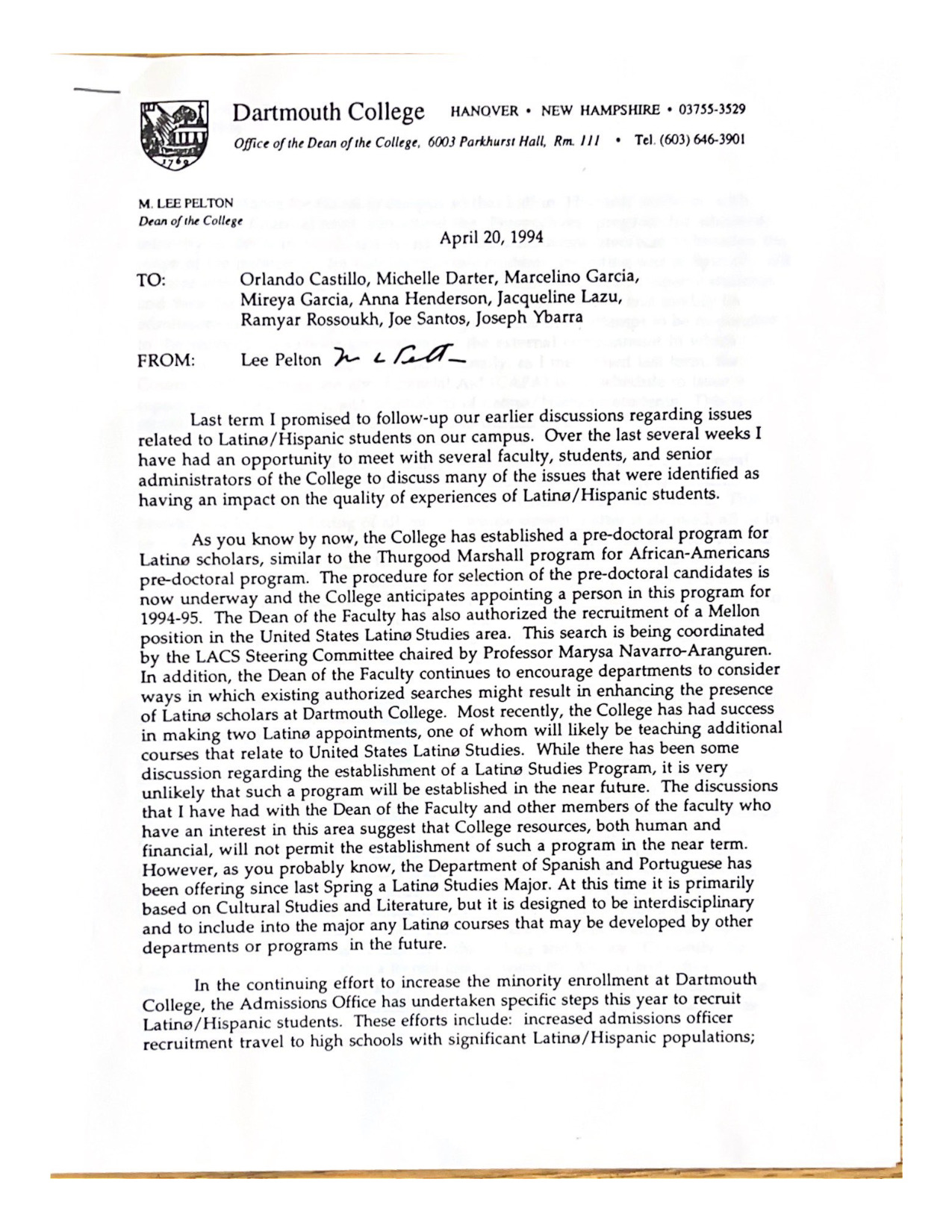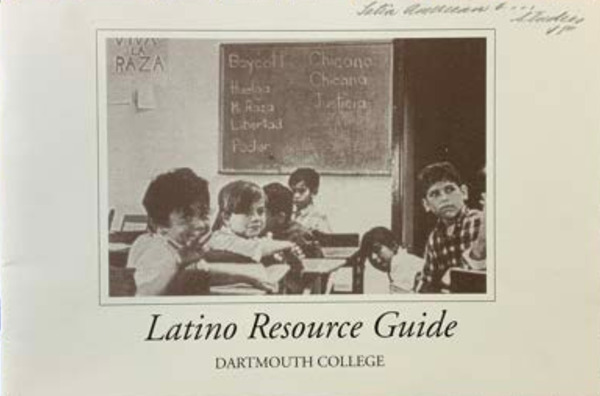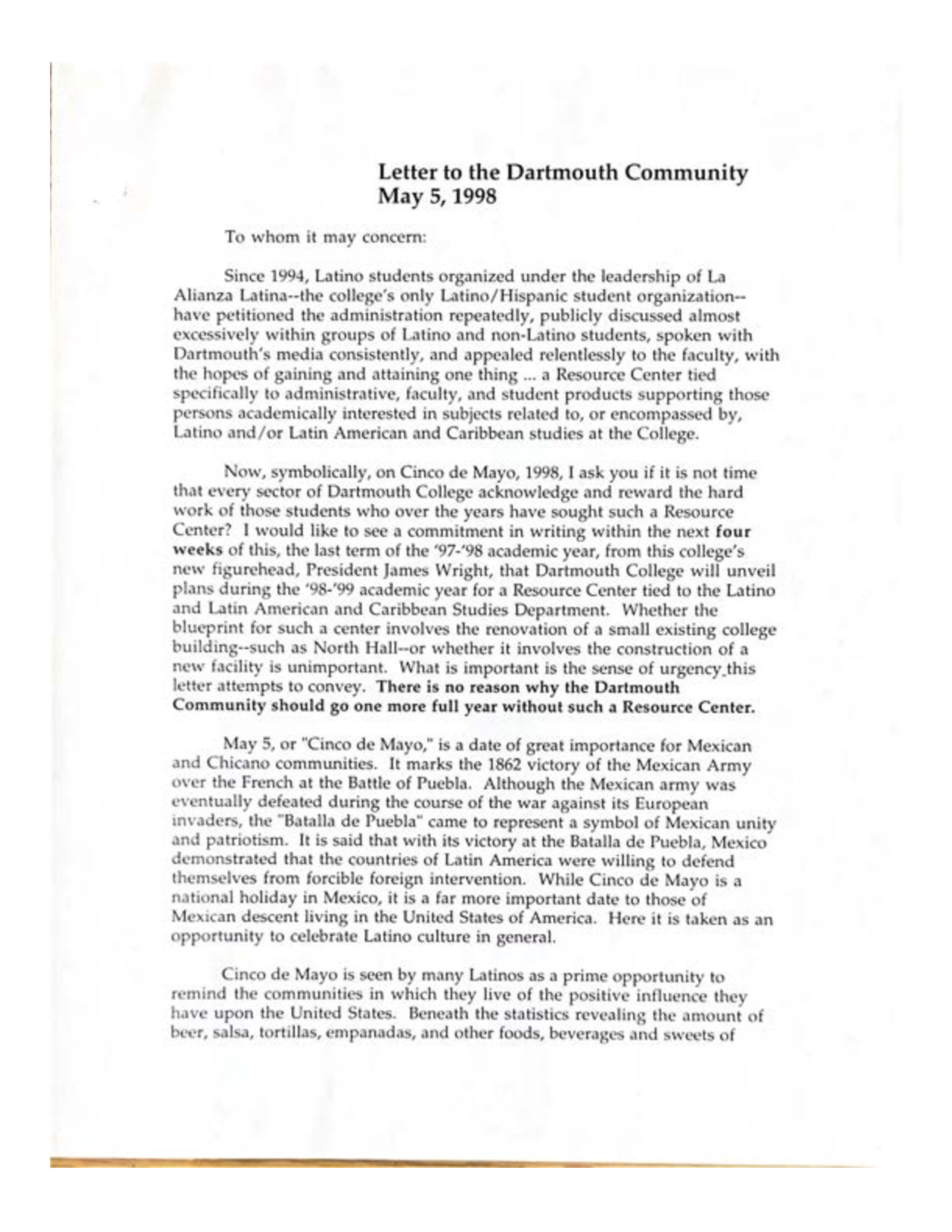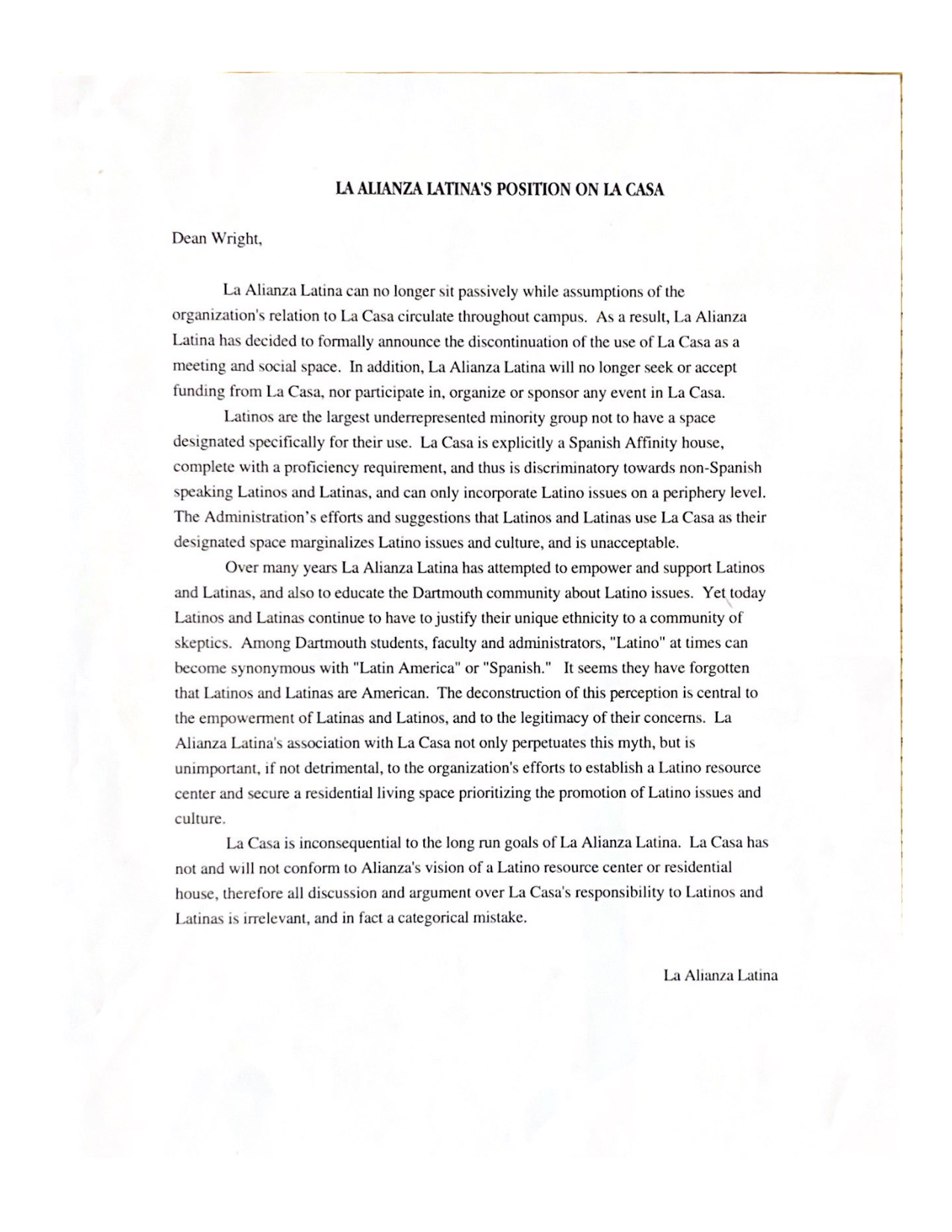Institutional Awareness of Latinx Students at Dartmouth and their Resources, Rosario Rosales '25
Throughout the early 90's, Dartmouth College began to face an increase in enrollment for latinx students. An increase in latinx students called for the need to address the struggles that came from attending a primarily white institution as a person of color. This increase in Latinx students arises from the establishment of IRCA, in 1986. As immigrants from Latin America were allowed to regulate their legal status, there was a rise in U.S. born, Latinx students who began to attend institutions like Dartmouth College. These students were shaped by the experiences of growing up within immigrant households, while facing the cycles of poverty enacted from previous conditions. Latinx students had to face the conditions their families faced, as well as live the difficult experience of being a first-generation American. These unique experiences are unlike those of the white peers who attend Dartmouth, making the academic and social environment a difficult place to thrive. As a result, both Latinx students and faculty began their own initiatives to establish on-campus resources that would provide support that Dartmouth administration was unable to provide on its own. The Latinx community and its allies prompted the initiative to create resources to respond to the failure to create awareness for Latinx students and their needs at Dartmouth. Every resource established on campus has served as a response to a specific need that was not addressed by Dartmouth. Additionally, while resources were created, they did not properly address Latinx student needs as they intended to.
Latinx Issues
It was important to recognize Latinx issues in order to ensure a successful Dartmouth experience for all students. No other group on campus faced them and no one else could address them but the Latinx student population. In the book Creating a College Culture for Latino Students: Successful Programs, Practices, and Strategies, author Concha Delgado-Gaitan discusses the obstacles Latinx students face in institutions of higher education. Unlike their peers, many Latinx students do not come from a family that has a history of attending college. Students who are the first in their family to attend college face struggle both academically and financially. Not only do these students come from households whose income is below the poverty level but they also typically come from high schools that are under-resourced and do not prepare them for academic rigor. This ultimately leads to high dropout rates, which highlights the importance of on-campus resources that can help Latinx students succeed at challenging institutions like Dartmouth.
On August 17, 1994, students and the administration gathered to discuss the needs of Latinx students on campus. The need for an advisor for Latinx students on campus stood out and represented the need to assist Latinx students both academically and on an emotional-level. Additionally, it also represents the need for guidance and encouragement to complete their studies at Dartmouth while being able to calirfy goals they might want to pursue. An advisor would close the obstacles faced by Latinx students, as they would have someone who would help them get the most out of their education at Dartmouth.
Resources for Latinx Students
The call for resources to serve Latinx students was on the rise.
La Alianza Latina
Throughout history, the Latinx community has been neglected. Latinx people who were able to regularize their status, as well as those who were unable to, faced anti-Latino sentiment stemming from immigration. Latinos were segregated into urban barrios in poor areas. Within these barrios, they would face endless cycles of poverty, drug addiction, gang activity, and health problems. These cycles became obstacles that were never addressed by the local government. Additionally, Latinx folk often faced discrimination since they were treated as a foreign underclass and grouped into stereotypes. In response, Latinx folk created their own resources that made up for the struggles they faced on a daily basis.
Established in 1968, the Young Lords branch in New York was established to support the Puerto Rican community, as they often fought for their own such as drug addiction, poor housing, and poor healthcare. One of the most infamous cases in which they advocated for the community was the People's Church takeover. For 11 days, the Young Lords took over the local church to use for community support such as a breakfast program for kids, daycare, and clothing drives. This form of advocacy, as well as the issues they responded to, manifested itself in institutions of higher education. The obstacles faced by Latinx households within their community translated into the way Latinx students were able to perform in school, often making it difficult for them to thrive in environments like the one at Dartmouth. The establishment of the Young Lords, as a resource, stemmed from the need to address the issues faced by the Latinx community that has been neglected by the state of New York. The Latinx experience at Dartmouth can be seen through a similar lens, as Latinx students also faced a similar pattern of neglect by the institution. Dartmouth was negligent to the unique experiences of Latinx students and the issues they faced as a result of them. Founded in 1985, La Alianza Latina (LAL) was a form of advocacy that manifested itself as a student organization on campus that worked to enhance the lives of Latinx students on campus. The existence of LAL reflects the demands of students of being incorporated into the Dartmouth community and into the institution. LAL advocated for the creation of social spaces for Latinx students and kept them in the loop of opportunities. Their accomplishments include the establishment of La Casa, which was a win for LAL as they demanded it for its creation to become a residential space for Latinx students. One of the most significant aspects of their work has been the LAL newsletter, which kept Latinx students informed about programs such as cultural events and Chicano conferences. One common attribute of this newsletter was giving Latinx students a platform to express their artistic ability. Within the newsletter are both poems and drawings created by either a member of LAL or the Latinx community at Dartmouth. The newsletter gave a platform to advertise cultural events on campus that could help students remain connected to their roots. Additionally, the newsletters emphasize weekly meeting schedules that students can follow in order to become and remain involved.
Advocacy and Resources on Behalf of Dartmouth Administration
Dean Lee Pelton
Lee Pelton held the position of dean of Dartmouth College from 1991 to 1998. As told by Jane Hodges, as alumni from the class of 1992, he was a dean that stood out from others and was characterized as the “dean who listens”. This was due to his willingness to participate in student meetings and engage with students both intellectually and socially.
Dean Lee Pelton played an important and relevant role in advocacy for Latinx students on campus. His contributions as part of Dartmouth's administration are significant, as the administration was known for its lack of action on Latinx issues. La Alianza Latina worked with figures like Pelton for the establishment of resources on campus. Collaboration between students and administrators matters because it means addressing issues that affect students directly to those who have the power to shape the Dartmouth environment. While students do shape Dartmouth in an environment that can be comfortable for everyone, the administration ultimately has the power to mold it into a place that is fit for success. Lee Pelton did help, as he was the one and only administrative figure that took direct action for Latinx needs and advocacy. His contributions were necessary to advance Latinx student demands because they brought awareness to them on an administrative level. The silence from other administrators meant negligence and a lack of interest to help Latinx students. Without Lee Pelton’s input, Latinx issues may have not been able to be addressed on an administrative level.
On April 20, 1994, Pelton sent out an email to Dartmouth faculty, students, and administration to address issues that "had an impact on the quality of experiences of Latino/Hispanic students". Besides stressing improvements such as admission rates and financial support for Latinx students, he also reveals the establishment of a resource guide for Latinx students. Working on these concerns with students is essential to providing input from students directly affected by the issues that were brought up and working to create an effective solution for them. Through this collaboration, Pelton was able to create effective resources with student input.
Latino Resource Guide
In his book, Youth, Identity, Power: The Chicano Movement, Carlos Munoz explores the ’60s and 70’s, when the Chicano Movement consisted of Chicano students attempting to establish a Chicano studies department within their respective universities. Hosted in 1969, the Santa Barbara conference was held to open a pathway for future generations of Chicano students through the establishment of the Chicano Studies program. The movement within this time period reflected the need to address the social, political, cultural, and economic conditions of the Chicano people within higher education, a place that holds power and influence. These patterns and goals have manifested themselves at Dartmouth, as Latinx students advocated for resources that would also pave the way for future generations of Latinx students at Dartmouth. Like the resources established to make progress towards the Chicano studies department, the Latino Resource Guide was also established to make progress towards making Dartmouth a place where Latinx students can thrive academically and socially.
In September of 1994, the Latino Resource Guide booklet was published with the goal of providing students with specific information regarding the curricular, programming, and advising resources related to Latinx interests. Through the efforts of this booklet, an increase in awareness of issues related to Latinx students took place and has led to the discovery of ways in which the college provides appropriate support on an academic level and recognition for the many accomplishments of Latinx undergraduates. The contents of this booklet include student organizations, supporting faculty, Latinx courses, and administrators who can serve as Latinx student advisors. The creation of this booklet speaks the most about Dartmouth’s awareness of its Latinx students and their need for academic inclusion, as it consists of everything Dartmouth has to offer to enhance their academic experiences.
In one section titled “Latino Courses”, the booklet goes into detail about courses students could take that are related to the Latino studies department. The section itself makes up for the lack of Latino studies at Dartmouth, an area of study that was heavily advocated for during the Chicano movement. This section provides insight on courses students can take that can empower them through learning about Latinx history within the United States. By addressing this section in the booklet, Latinx students are able to learn more about courses offered at Dartmouth that pertain to them and their heritage.
In one section titled “Faculty”, the booklet lists and provides background information on Dartmouth faculty who are highly supportive of Latinx students. The section itself is meant to show students potential mentors and their research projects. By including this section in the booklet, Latinx students are able to learn about potential mentors who can assist them in their Dartmouth careers and work on research projects with them that pertain to their interests.
The creation of this booklet involved meetings between Latinx students and administrators over the need to better address their concerns. Its existence speaks of the lack of faculty, courses, and support available for Latinx students at the time
Establishment of a Resource Center
Throughout the year 1994-97, multiple meetings fostered between members of La Alianza Latina, faculty, and administration were held to discuss the proposal of the establishment of a Latinx student resource center. These meetings involved the justification of the need for a resource center as well as drafting a proposal to submit to the administration. The meetings were also documented and recorded into a 20-page summary report, later emailed out by Dean Lee Pelton. The existence of this document is essential as it represents the advocacy that it takes to establish resources for Latinx students on campus. The report expands over the course of 3 years, where La Alianza Latina starts off the discussion of the establishment of the resource center in 1994. It would be until 1997 that the final proposal of the resource center would be reached and submitted for approval. The lengthy process of this proposal reveals the difficulty Latinx students faced when advocating for their needs. Obtaining resources to support them was never easy and took up a lengthy process and fight with administrators. Keeping a record of these documents is important to understand the struggle it takes to address the needs of the Latinx community, even in institutions of higher education.
In the report, Ramyar Rossoukh, former president of La Alianza Latina is documented stating that “the Latino community is the largest under-represented ethnic community that doesn't have a space of its own and the issue may be more importantly the lack of permanent institutional support from Dartmouth for Latino students." The demand for this resource speaks about the lack of academic and well-being support inclusion. Dartmouth has always been an institution full of opportunities and resources for students but the fact that the Latinx community felt the need for this center means that what Dartmouth had to offer was not applicable to them.
It would not be until 2001 that the resource center and a residence hall would be established to address these demands.
Criticism of Resources
Advocacy for Latinx issues includes improving current resources that have been created to support them. Just because a resource exists, does not mean that it is effective. It should not be assumed that the existence of a resource means that issues that it is designed to help with are solved. The creation of resources at Dartmouth never meant that issues that Latinx students faced were automatically solved.
As part of its mission to improve Latinx student life on campus, La Alianza Latina criticized La Casa for not upholding its mission of supporting Latinx students due to its focus on being a language house. La Casa has the requirement for speaking Spanish, which dismissed Latinx students who could not speak Spanish and neglected the idea that Latinx students can be American too. La Casa also had a heavy focus on the language itself and disregarded any other aspects of Latinx culture.
La Alianza Latina withdrew its association with La Casa by refusing to use it for meetings/events and by no longer accepting funding from it.
Criticism for resources such as La Casa is important in order to keep the resource effective to continue addressing Latinx issues. An effective resource is one that will enhance the lives of Latinx students within the time frame that it was established and beyond. La Casa was not meeting those standards, which is why it was so heavily criticized and recalled.
Conclusion
Advocacy for Latinx student issues and the creation of resources was never initiated by Dartmouth administration and faculty, but rather by Latinx students. Historically, it has always been this way as seen with the Young Lords and the fight to establish the Chicano Studies department. The awareness of Latinx students and the establishment of resources paved the way for current and future generations of Latinx students at Dartmouth to thrive. Key themes that stand out within this timeline include self-advocacy and long-term collaboration with the administration. This is what it took to incorporate Latinx students into the Dartmouth community
Bibliography
1. Dean Wright email, 1994, Box 12889, Folder 1, Dean of Faculty Records, Dartmouth College
2. Delgado-Gaitan, Concha. Creating a College Culture for Latino Students : Successful Programs, Practices, and Strategies. Thousand Oaks, California: Corwin Press, 2013.
3. Discussions for Resource Center, May 5, 1998, Box 12889, Folder 1, Dean of Faculty Records, Dartmouth College
4. Fernaìndez, Johanna. The Young Lords: a Radical History. Chapel Hill: The University of North Carolina Press, 2021
5. La Alianza Latina Newsletter, 2000, Box 1, Folder 2, Latin American and Caribbean Studies Collection, Dartmouth College
6. Latino Issues Meeting Agenda, 11 August 1994, Box 12889, Folder 1, Dean of Faculty Records, Dartmouth College
7. Latino Resource Guide Booklet, September 1994, Box 1, Folder 2, Latin American and Caribbean Studies Collection, Dartmouth College
8. Lee Pelton email, April 20, 1994, Box 12889, Folder 1, Dean of Faculty Records, Dartmouth College
9. Muñoz, Carlos. Youth, identity, power: the Chicano movement, London: Verso New York,1989
10. Sandoval-Strausz, A.K.. 2019. Barrio America: How Latino Immigrants Saved the American City. New York: Basic Books, Hachette Book Group
11. Hodges, Janes. “M. Lee Pelton”. Dartmouth Alumni Magazine, October 1997. https://archive.dartmouthalumnimagazine.com/article/1997/10/1/m-lee-pelton






